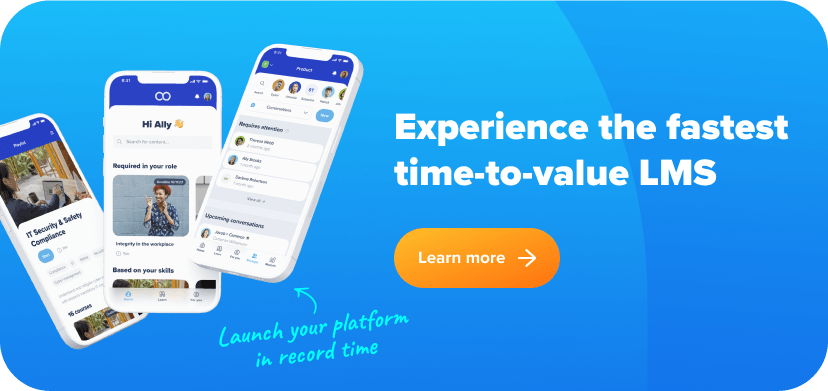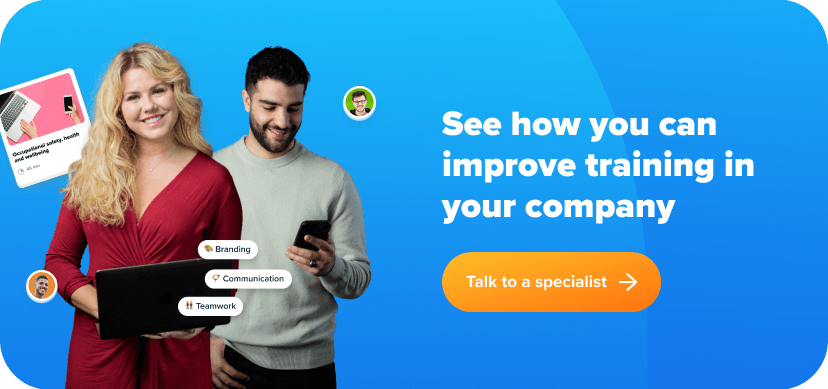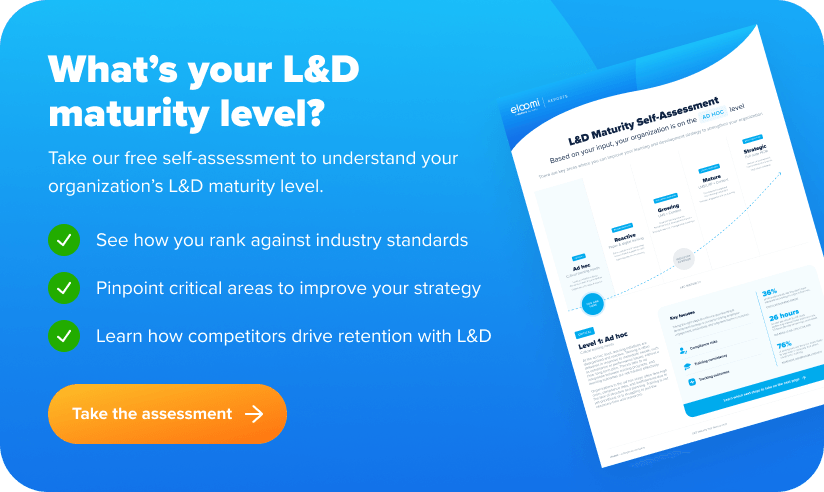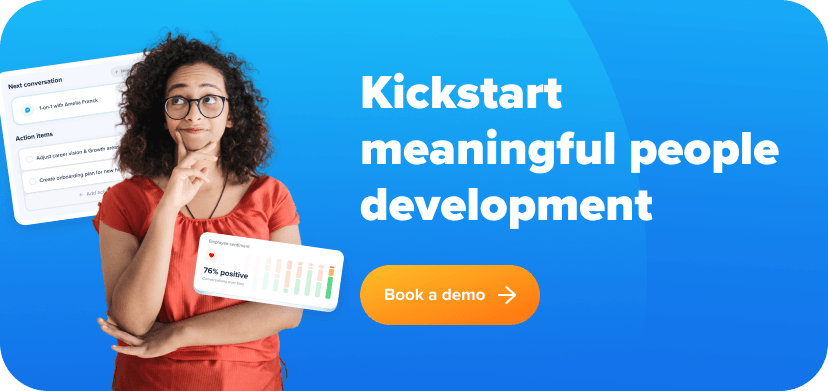There can often be a negative perception of training due to past experiences with tedious programs, or from the perspective of administrators, they may be reluctant to dive in due to the time required for learning a new system. Therefore having an effective adoption strategy is important for making sure that users fully embrace the platform.
Whether your goal is to improve employee training or streamline compliance, a well-crafted strategy will make the adoption process smoother and save you time, money and unneeded frustration. Here we explore why an adoption strategy is needed, breaking down its essential components and walking you through the steps to create one that fits your organization.
Why an LMS adoption strategy is essential for organizations
An LMS adoption strategy is a roadmap that guides how you introduce the LMS, how employees interact with it, and how it supports broader business goals. Without a well-thought-out strategy, organizations may quickly struggle with poor user engagement, miss out on important features, and, ultimately, fail to see the ROI they’re looking for. In fact, research shows that only 54% of organizations who have an LMS actually utilize all of its features, resulting in lost investment and wasted potential. An adoption strategy therefore ensures that:
- Stakeholders are aligned on goals and expectations.
- Employees understand the benefits of the new LMS.
- Transition challenges, such as resistance to change, are kept to a minimum.
By preventing a situation where the LMS is purchased but never fully integrated into the workflow, an adoption strategy instead lays the groundwork for smooth implementation, driving long-term success.

Key components of an LMS adoption strategy
Every successful adoption strategy includes a few key components that address various aspects of implementation and user engagement, so let’s break these down:
Stakeholder engagement
Involving key stakeholders such as department heads, HR teams, IT professionals, and end-users from the beginning will help in gaining buy-in and support for the LMS.
Each of these groups brings valuable insight into what they need from the platform, ensuring the LMS addresses real challenges and goals. Engaging stakeholders also helps create advocates for the system within the organization, improving user acceptance.
Clear objectives
What do you want your LMS to achieve? Whether your focus is compliance training, skills development, or employee onboarding, it’s essential to define clear objectives.
Set specific, measurable goals for both the short and long term, such as increasing course completion rates or improving employee satisfaction with training programs. These objectives will guide the selection of LMS features and help track the success of your implementation.
Change management
Resistance to new technologies is common in any organization; in a world with such a reliance on digital tools, people can quickly become disgruntled by another platform to get to grips with. A change management plan can help ease this transition by addressing concerns early on and outlining the benefits of the new system.
A change management plan should include communication strategies to explain why the LMS is being introduced and how it will benefit employees, as well as offering incentives or rewards for early adopters to foster some excitement.
This could also include training a team of managers or employees who can champion the new platform internally. With more people onboard and able to help others use the new tool right from the start, organizations see far more successful adoption.
Training and support
Another common blocker for new LMS platforms is how confident users feel navigating it. We’ve all read instructions or watched tutorials and often it’s not until getting hands-on where suddenly we realise that actually, perhaps this may be trickier than originally thought. Therefore successful adoption hinges on whether your users do in fact feel confident navigating the new platform, and it’s exactly why providing training and ongoing support is so critical.
It’s recommended to develop a comprehensive training program that includes hands-on workshops, video tutorials, and written guides. Often these are provided by the LMS vendor, with eloomi also providing ongoing support through live chat and help desks to help tackle any issues that learner may have.

Steps to develop your LMS adoption strategy
Now we know what should be included, let’s look at the steps involved for actually crafting an LMS adoption strategy.
1. Assess needs and requirements
The best place to start is identifying your organization’s training needs and technical requirements. Understand your learners, whether it’s employees, customers, or partners, to determine what features they will need to thrive.
Think about whether your LMS should support mobile learning, multi-language capabilities, or a mix of online and on-site training. This assessment phase is the foundation for aligning the platform’s features with your business goals.
2. Choose the right LMS
Easier said than done, but once your requirements are clear, it’s time to choose an LMS that aligns with your strategy. Consider a user-friendly, all-in-one platform like eloomi that not only offers learning capabilities but also integrates performance management features.
eloomi streamlines employee development and learning, making it easier to track both training progress and performance outcomes. For more tips on selecting the right platform, see our guide on how to choose the right LMS.
3. Develop an implementation plan
An implementation plan details the rollout of your LMS and should include timelines, key milestones, and responsible teams. It’ll be worth considering a phased rollout that starts with a pilot group of users to gather feedback and make necessary adjustments. As part of this, it’s important to make sure all stakeholders know their roles, whether it’s IT setting up integrations or HR preparing training materials.
4. Monitor and evaluate
After implementation, continuous monitoring is essential to identifying what’s working well and what needs adjusting. Gather feedback from users, track engagement metrics such as course completion rates, and compare these against your original objectives. If necessary, adjustments can be made to the LMS configuration itself, although offering refresher training to boost user adoption is another option.

Best practices for successful LMS adoption
Beyond the basic steps, several best practices can further improve the success of your LMS adoption strategy.
UX and accessibility
Employees are more likely to engage with the LMS if it’s easy to navigate and accessible on multiple devices, so ensuring accessibility for all users, including those with any disabilities, further enhances adoption rates.
Intuitive design and straightforward navigation can reduce the learning curve and allow employees to focus on learning rather than racing through content. It’s also key here to consider where your learners learn best. Access to training via mobile might be essential for retail and hospitality workers, while LMS platforms with handy integrations like Microsoft Teams or LinkedIn learning can help office-based employees access training in the flow of work.
Interactivity
One of the best ways to keep learners engaged, at any age or level, is through interactive elements. Gamified learning paths, quizzes, and, with eloomi, the ability to earn certifications can make the learning experience more rewarding.
The best LMS platforms allow organizations to create engaging learning modules that encourage users to actively participate, rather than passively consume content.
Realistic goals for employees
As with anything in life, having goals to work towards helps us stay focused and on track. The same applies here; by setting achievable learning goals, you can help employees stay motivated.
These goals should align with their current roles and career growth opportunities. For example, breaking larger courses into shorter modules can make learning feel more manageable, leading to higher completion rates.
Providing training for employee
Offering continuous training can play a big role in making sure employees feel confident using the LMS. Initial training can be followed by periodic refreshers or advanced tutorials as users become more familiar with the platform.
Providing a support network, whether through LMS admins, peer mentoring, or a help desk, provides employees with the resources they need to resolve any issues they run into.
Seeking employee feedback
Regularly ask employees for their opinions on course content, how easy it is to navigate, and the overall user experience. Their insights can help you identify areas for improvement, whether that’s streamlining certain features or expanding the types of content available. You can also gather feedback directly within your LMS, or make L&D feedback opportunities a key part of manager performance management check-ins.

Impact of successful LMS adoption with eloomi
A standout example of successful LMS adoption is when Johannes Fog, a Danish DIY retailer, chose eloomi as their LMS platform. Their challenge was to engage 500 employees in product training to improve customer service. Before eloomi, it was hard to get employees to participate in training and apply it to their work.
Using eloomi, including its purposefully designed gamification features, Johannes Fog introduced competitions and rewards, including prizes for the highest-scoring employees and stores, to motivate participation.
The LMS adoption was a big success and employee engagement skyrocketed, with 80% saying they could use the knowledge gained in their jobs. Some even completed all 150 modules to earn extra points. By implementing eloomi, Johannes Fog successfully boosted training engagement and improved customer service. Read the full customer story to find out more.
Launching your LMS for success
Developing a comprehensive LMS adoption strategy will help to make sure your new platform is integrated into your organization seamlessly. By setting clear goals and following best practices, you can maximize the value of your LMS and encourage long-term user engagement. Platforms like eloomi, with their focus on interactivity, accessibility, and performance management, make the adoption process easier and more successful.
Ready to get started? Contact eloomi today to learn how our platform can help you implement a winning adoption strategy.






